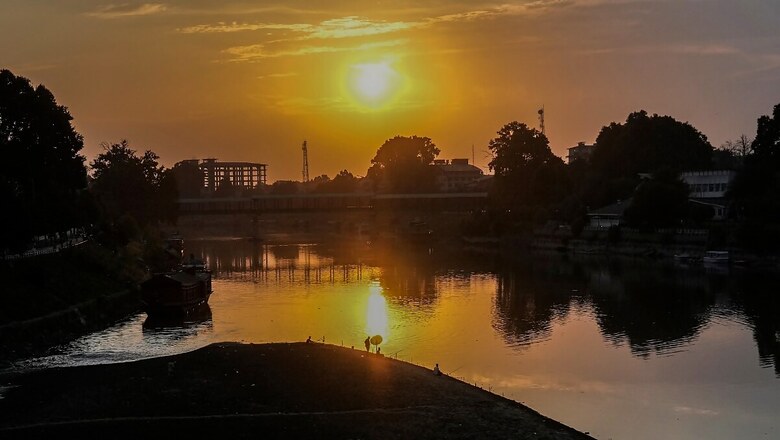
views
Flanked by the snow-capped Himalayas, the picturesque Kashmir Valley is experiencing a warmer-than-usual July as maximum temperatures surged past 35℃, nearly 4-5℃ higher than what is usual for this time of the year. The rains have been scarce, and the monsoon deficit has touched nearly -34%.
Srinagar recorded 36.2℃ on Sunday, nearly 6.3℃ above-normal and the highest since 1999, when mercury touched 37℃ on July 9. It was 35.7℃ on Saturday. The highest-ever July temperature here is 38.3℃, recorded on July 10, 1946. The night-time temperatures, too, increased to 24.6℃, compared to the normal of around 18.8℃.
The mercury settled at least 4℃ to 7℃ above-normal during the day across several sub-stations — 31.1℃ in Pahalgam, 35.8℃ in Kupwara, 36.5℃ in Muzaffarabad, and 35.6℃ Qazigund, which saw its highest-ever temperature, while it was almost 8.7°C above-normal in Kukernag. The Divisional Commissioner, Kashmir ordered suspension of classes for students up to the primary level in both government and private schools in the Kashmir division on July 29 and 30.
BUT WHY IS IT SO HOT?
“The temperatures normally hover around 29-30℃ at this time, but they are settling at around 35-36℃. Srinagar was even warmer than Jammu, where it was 32.2℃. This year, the region has not received as much rainfall as it has in previous years. The western disturbances (WDs) have been few and far between, and the dry spell has lasted longer,” senior IMD scientist Braham Pal told News18.
The India Meteorological Department (IMD) has so far refrained from declaring a ‘heatwave’ and issued an alert for ‘hot and humid’ day.
“The region is experiencing a localized increase in temperature. The mercury shot up for a short period as the clouds passed, but it will soon come down as we are expecting widespread rains over the region in coming days. This is different from a heatwave, which is a large-scale phenomenon, and is declared only when conditions are likely to persist for more than two days,” said Dr Soma Sen Roy, senior scientist, IMD Delhi.
Unlike the plains, a heatwave is declared in the hill regions, when the temperature crosses 30℃ or is at least 4.5℃ above-normal in two meteorological sub-stations for two consecutive days, and a heatwave is declared by IMD on the second-day. It becomes severe when the departure exceeds 6.4℃ prompting emergency measures to prevent any adverse impact on the health of the people.
MONSOON DEFICIT SURGES TO -34% IN J&K
After a snow-less January, and a delayed spell of winter snowfall in February-March, the Himalayan region has reeled under subpar rains this year. The western disturbances (WDs) – extra tropical storms that bring rains over Kashmir and adjoining areas — have been few and far in between, and mostly feeble. In June, there were only three WDs against the normal of 4-5 in June, leading to a staggering rainfall deficit which continues even till date.
As of July 29, the rainfall deficit in Jammu and Kashmir (subdivision) and has touched 34% even though the monsoon rains are in excess of 3% over the country. July is the wettest month of the year for India, but the rainfall deficiency had reached -67% in Srinagar, -60% in Anantnag, -69% in Badgam, -49% in Pulwama and nearly -70% in Bandipore till July 24.
However, the IMD has forecasted an increase in the rainfall activity over the next few days, which may bring down the shortfall to some extent.
2024 HOTTEST YEAR ON RECORD
However, climate scientists warn that more weather records are likely to be broken in the near-future as global warming continues. 2023 ended as the second-warmest year for India with average annual temperatures nearly 0.65°C above the long-period average – the highest since 2016.
This year, almost the entire India, barring the Northeast was scorched by deadly heatwaves from April to June claiming numerous lives across states. Northwest India experienced its warmest June in 123 years with a spike of nearly 1.65℃ in the average monthly temperature, while it was the hottest-ever February for the Southern peninsula.
Latest projections show that 2024 could surpass 2023 as the hottest year on record globally. July’s average global temperature is also projected to be 1.3-1.7°C above the long-term average, exceeding the previous July record of 2019 by 0.2°C. The European Union (EU)’s Copernicus Climate Change Service recently declared that the world saw its hottest days on record between July 21 to 23.
The UN-Intergovernmental Panel on Climate Change (IPCC) has already warned of a rapid rise in the scale, intensity, frequency and duration of extreme-heat events across the world as global temperatures rise by 1.1℃ above the pre-industrial levels. Scientists are certain that its impacts will be more profound in vulnerable ecosystems like the Himalayas.



















Comments
0 comment